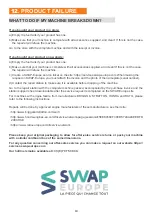
EN
d)
Support large panels to minimise the risk of blade pinching and kickback.
Large panels
tend to sag under their own weight. Supports must be placed under the panel on both sides,
near the line of cut and near the edge of the panel.
e)
Do not use dull or damaged blades.
Unsharpened or improperly set blades produce narrow
kerf causing excessive friction, blade binding and kickback.
f)
Blade depth and bevel adjusting locking levers must be tight and secure before making
the cut.
If blade adjustment shifts while cutting, it may cause binding and kickback.
g)
Use extra caution when sawing into existing walls or other blind areas.
The protruding
blade may cut objects that can cause kickback.
Safety instructions for saws with pendulum guard and saws with tow guard
Lower guard function
a)
Check the lower guard for proper closing before each use. Do not operate the saw if the
lower guard does not move freely and close instantly. Never clamp or tie the lower guard
into the open position.
If the saw is accidentally dropped, the lower guard may be bent. Raise
the lower guard with the retracting handle and make sure it moves freely and does not touch
the blade or any other part, in all angles and depths of cut.
NOTE Alternate wording for "retracting handle" is possible.
b)
Check the operation of the lower guard spring. If the guard and the spring are not
operating properly, they must be serviced before use.
Lower guard may operate sluggishly
due to damaged parts, gummy deposits, or a build-up of debris.
c)
The lower guard may be retracted manually only for special cuts such as "plunge cuts"
and "compound cuts". Raise the lower guard by the retracting handle and as soon as the
blade enters the material, the lower guard must be released.
For all other sawing, the lower
guard should operate automatically.
NOTE Alternate wording for "retracting handle" is possible.
d)
Always observe that the lower guard is covering the blade before placing the saw down
on bench or floor.
An unprotected, coasting blade will cause the saw to walk backwards,
cutting whatever is in its path. Be aware of the time it takes for the blade to stop after switch
is released.
Warning: Keep hands away from the cutting area and blade. NEVER place your hands behind
the saw blade since kickback could cause the saw to jump backwards over your hand. Keep
your body positioned to either side of the saw blade.
1.
Check the lower guard for proper closing before each use. If the saw is accidentally
dropped, the lower guard may be bent. Raise the lower guard with the lower guard lever
07






































